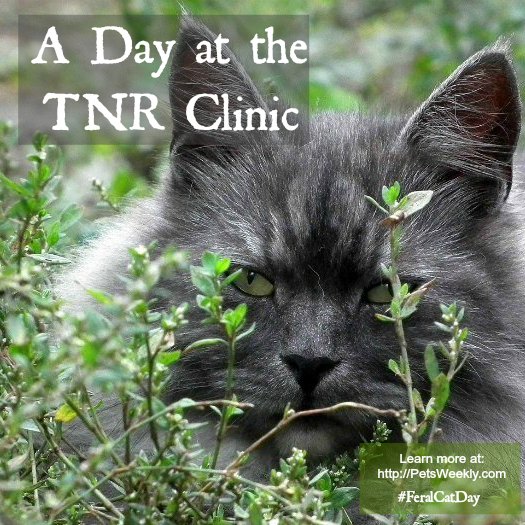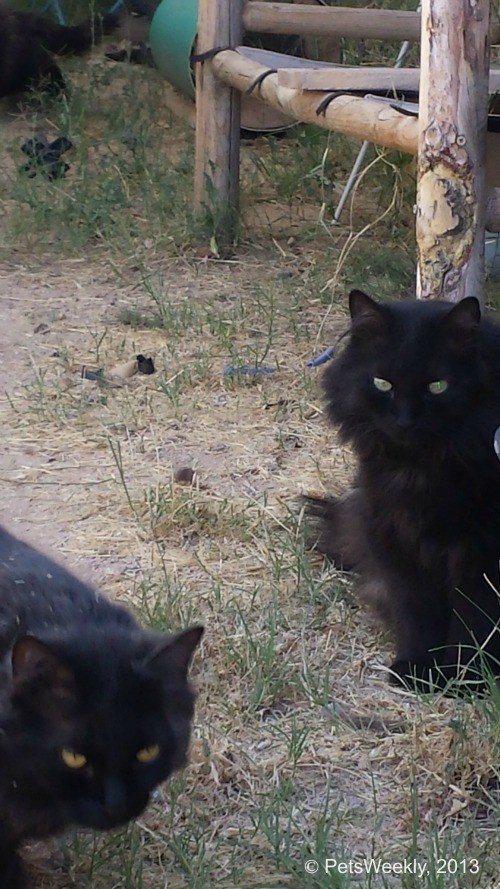Feral Cat Day
Share

 The day starts out like any other as you approach the trap you’ve been watching for the last hour. The neighborhood cats are afraid of you, but they shouldn’t be – you come to offer your help, not to harm them.
The day starts out like any other as you approach the trap you’ve been watching for the last hour. The neighborhood cats are afraid of you, but they shouldn’t be – you come to offer your help, not to harm them.
The long-haired white male with bright, blue eyes stares back at you as you approach. You realize he can’t be more than a few months old. He ceases his frantic efforts at escape and eyes you warily as you approach.
He’s already shredded the newspaper lining and turned over the can of tuna-flavored cat food you used as bait, and it’s only been a few minutes since you’ve trapped him. It will be at least a day before he is free from the cage, but that can’t be helped.
You apologize softly, in what you hope is a calming tone, then quickly glance him over – checking for problems that must be treated while he is under anesthesia. His long hair is matted and has even been torn out in the throat area.
Check.
You spot several fleas, and notice one of his ears are infected (maybe from a fight).
Check.
Jotting the information down on a clipboard, you gently drape a towel over the top of the cage before loading him into the back of your truck.
If you’re luck holds, you will have repeated this scene six more times by morning (and that’s not counting the ones that you will have to release because a missing ear tip signifies that they have already undergone the process).
Today is October 16 – National Feral Cat Day as it has become known internationally by animal rescuers, thanks to the committed efforts of Alley Cat Allies.
It is a day to recognize the growing problem of feral/community/stray cats, and their place in our lives whether we are aware of it or not.
National Feral Cat Day is more than just thinking about the problem, though. It is a day of action – where veterinarians nationwide offer their services to these wayward waifs.
[blockquote cite=”Saint Francis of Assisi”]Start by doing what’s necessary, then what’s possible, and suddenly you are doing the impossible. [/blockquote]By 4:00 am, you have maxed out the six traps. The contents of your truck include a strikingly handsome black male, who you suspect is deaf; a calico female who recently gave birth; two gray male short-haired cats; and a friendly tabby, and the first one you caught – who you’ve affectionately nicknamed “Booger,” (due to the late hour and the fact that he has a minor sinus infection).
 The site for the spay/neuter clinic is as wild as the hundreds of cats that have been brought here. Trapped, distressed, and yowling, they await their unknown fate. You sign in at the front desk and the volunteer thanks you – thanks you – for participating.
The site for the spay/neuter clinic is as wild as the hundreds of cats that have been brought here. Trapped, distressed, and yowling, they await their unknown fate. You sign in at the front desk and the volunteer thanks you – thanks you – for participating.
You are fortunate to belong to such a noble group.
Today, you are trading out the cost of the surgeries for this small “colony” of cats by volunteering. You are assigned to the the “post-op” section. And so, after your cats cages are tagged to assure a return to the same location, you enter the clinic and report for duty.
It’s quite a spectacle. On duty are five veterinarians and too many volunteers to count. Your assignment is in the hallway of the hospital where they have set you and another volunteer up on a long cardboard table. Your job is to administer vaccinations and check, diagnose and treat each cat as they are released from surgery for any physical ailment that can be resolved in the 30-40 minutes it takes for them to wake up.
The assembly line of felines has already started so you make an attempt to introduce yourself to the other volunteer assigned the same duties. But, there is no time for idle chatter. You prepare as, one by one, other volunteers carry the cats from the “staging” area to the room where cats are put under with a syringe on a long stick administered by a very qualified vet tech; to the operating table where they will be rendered sterile. Within minutes, another group of volunteers shuttles them to your table (where you will be standing for the next few hours).
By the time they get to you, the cats will have their ears tipped (which indicates they have been sterilized), and will be spayed or neutered.
Your job is to clean their wounds, check for parasites, vaccinate, brush or cut out any severe mats that could later become infected if the cat tries to chew it out. You’ll administer sub-cu fluids to those who are dehydrated, and finally pass them off to a volunteer who gently returns them to the tagged cage.
Volunteers hover around the traps, which are stacked five high. Their job is to rotate their small bodies every 10-15 minutes. This helps ensure liquid does not settle into their lungs and that they are not experiencing any reactions to the anesthesia.
All of this must be done before they wake and although you are a writer who is accustomed to tight deadlines, the pressure threatens to drown you as a seemingly endless assembly line of tranquilized cats come through. You’ve been there only 90 minutes, and already you have treated twelve cats. At one point, you had four cats lined up on a table and your post-op partner became so overwhelmed they had to leave for a few minutes.
But you fight through the stress and exhaustion, consoling yourself with the knowledge that these cats will now live a healthy life because of you. The fatigue drifts away, and you find enough renewed energy to push forward.
The cats are groggy and in foul moods when they awaken in the small cages. It’s a necessary discomfort. The younger volunteers, new to the world of cat rescue, are talking softly to the cats in a futile attempt to calm the feral felines. You finally have to tell them to just throw a towel over their cages – these cats are not the type you console. They are wild and independent and deserve all of the rights they so vocally demand.
Eight hours and nearly 190 cats later, everyone in the clinic is exhausted and ready for a good nights sleep. But your day is far from over.
You check on the six cats that you brought, making sure that they are the correct ones, and load them into your truck. They will need to be observed until the following morning, and then set free once more.
This time, however, they will not be transmitting diseases or breeding as they patrol the neighborhood. They will be calmer, there will not be as many fights, and they will not spray nearly as much as they did before. They will, in short, be much less of a nuisance. And the biggest benefit is that they will keep other feral cats out of their territory. Perhaps the youngest ones may one day even be domesticated. You smile softly to yourself, knowing that the phrase “domesticated cat” is an oxymoron, but hold to the hope regardless.
It has been a good day, and one that will remain in your memory for a lifetime.
During the next few years, you and a few volunteers you’ve recruited from the neighborhood, will continue to care for this colony of wild cats. You will feed them, build a shelter for them, and observe the animals without ever touching or petting or holding any of your charges.
They are your responsibility now, but you have done your best to educate your neighbors, and you hope that additional volunteers will continue to turn up – to help you shoulder the burden. It can become a massive responsibility for one person, however, it is well worth it – for you have helped save the lives of these animals, and you have helped stem a feral cat problem in your neighborhood. Each year, you find more volunteers willing to help. You have helped stabilize a colony, reduced the chance of new kittens being born, and have dramatically reduced the chances of new cats joining the neighborhood.
When it’s finally time to release the cats, nearly 36 hours later, the one you’ve christened “Booger” stays in his cage a moment longer than necessary and glances up at you. You repress an urge to reach out and pet his beautiful coat, knowing that an attempt to do so would most certainly result in a bite and a trip to the hospital. Instead, you nod and tap the back of the cage, encouraging him to venture forth and reclaim his territory.
And then, without so much as a glance back, he bolts from the trap and disappears behind a nearby hedge. You sigh and wave goodbye, because it’s all you are can do.
Nevertheless – a warm glow spreads over you, because you know that today was one of your most successful ones.

To learn how you can be of assistance during National Feral Cat Day, or better yet, begin efforts in your area to start a TNR (Trap/Neuter/Release) program in your area, visit Alley Cat Allies for detailed information. And if you can’t participate, please try to make a donation, any funds are very much appreciated in continuing this national effort.
Informative Articles about Feral Cats:
- Winter Caretaking of Feral Cats How we can help feral cats make it through a long winter comfortably.
- Keeping Feral Cats Warm This Winter Every cat should be stay warm in winter. Here are some easy ways to help them.
- Feral Cat Day A look inside the life of a TNR volunteer
- Neighborhood Cat Pests: Don’t want feral cats hanging out in your yard? That’s okay! We got you covered with lots of humane ways to keep them from your home.
Stories:
- The story of a rescue – when you just can’t do it anymore.
Rescue Me: A poem for animal rescuers
- A poem about rescuing all types of animals
- A hilarious viral video about rescuing animals that we think you’ll love!
Close Encounters of the Furry Kind
- A lovely narrative of what it’s like to be a caregiver for a feral cat colony.










